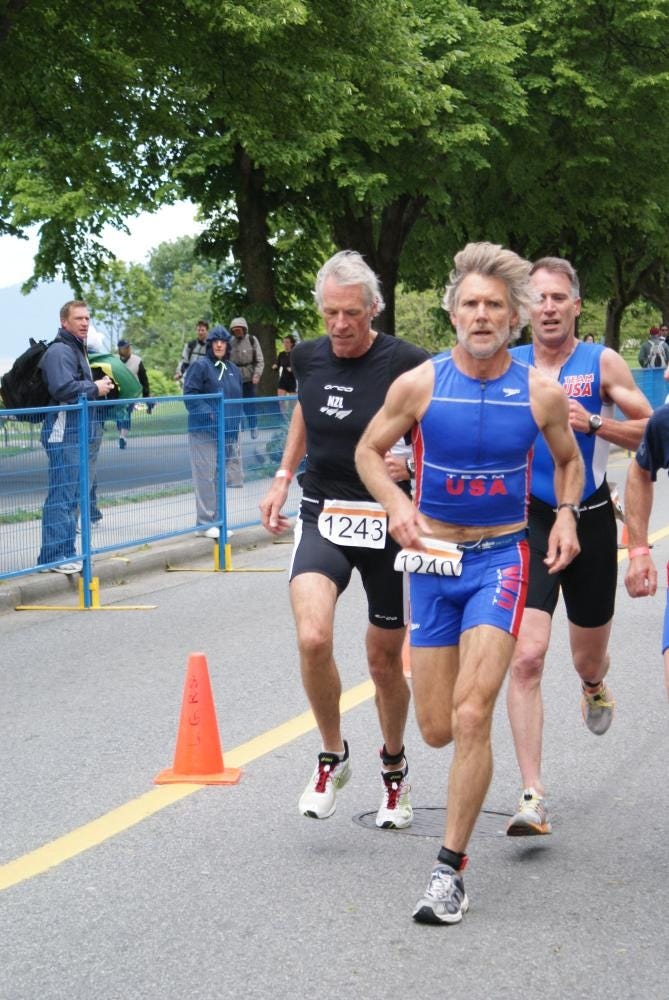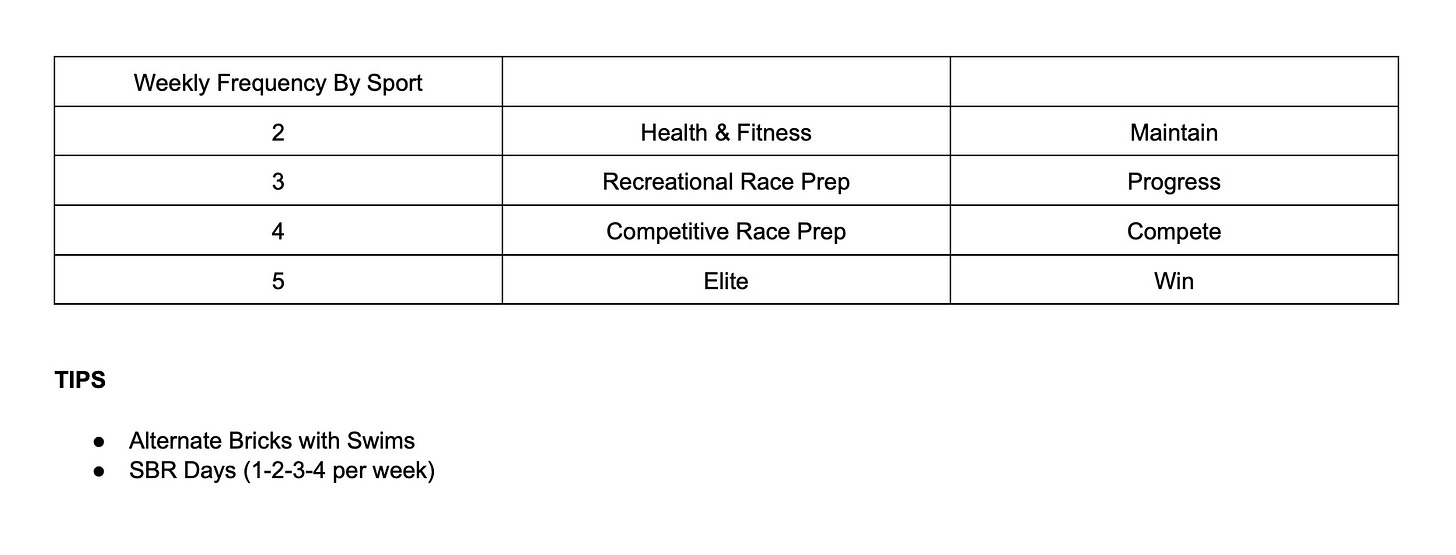
John and I started by introducing the Basic Week for a Recreational Athlete.
We then gave you an example of the sort of week required for an amateur athlete who wishes to compete at an event.
Today, I want to step back from the specifics of week structuring and discuss how to apply the Basic Week Philosophy.
The Philosophy
As John outlined, there is a minimum weekly frequency, and volume, in order to…
Maintain
Progress
Compete
To those, I’d add another level => Winning
That’s going to result in a table that looks like this…
Single sport athletes, remember we’re working with three sports here. So we’re looking at anywhere from 9 to 18 sessions per week.
The correct “minimum” frequency depends on many factors, including:
Your Life Structure
Your Race Goals
Your Capacity To Recover
As well, there are diminishing returns as athletes move up the performance hierarchy. Each level requiring more commitment given, than performance gained.
Let’s repeat that, differently:
More sessions result in smaller gains
Two many sessions result in excessive fatigue and maladaptation
So the optimal strategy is to set the Basic Week under what the athlete can tolerate. From this well-tolerated baseline, the athlete can cycle load upwards.
Minimum Frequency
Minimum frequency applies in two important situations:
The Off-Season
When Pushing Load
No Long Gaps - if you want to improve at something, then do it year-round. Swim, bike, run, strength… it is much easier to “stack the seasons” if you maintain minimum year-round frequency.
Hit Your Minimums - drop volume in your “favorite” and “focus” sports to ensure you hit the minimum frequency in all your sports. Swimming, and running, can be ignored at bike-focused camps. An easy fix is to do-it-first. Start your day with a short session of your “off-sport.”
John adds, in your typical week:
Focus on priority discipline(s) first (often that is in the morning) and do the lower priority sessions later in the day, if you run out of time, it matters less.
Multisport Days
As we outlined in Combination Workouts, a training triathlon is an effective endurance session.
Single-sport athletes can embrace this principle by using crosstraining to create well-tolerated long days.
Multisport athletes can combine shorter sessions to make is easier to hit minimum frequency targets.
Three favorite examples:
Runners: A bike-run session where the bike is used to create a total session duration equivalent to the athelte’s running race.
Recreational Triathletes: Alternating bike-run days with swim days.
This gives a swim, a bike and a run within a 24 hour period.
It can also be used to create a lower-body rest day (swim only).
Competitive Triathletes: Using multiple swim-bike-run days within a training week.
Starting, and ending, the microcycle1 with a Multisport day takes the pressure of the workout frequency within the rest of the training block.
An example for a competitive amateur:
Tuesday - SBR, separate workouts, faster or specific work
Wednesday - Swim
Thursday - Brick, strength
Friday - Swim
Saturday - SBR, training triathlon, endurance
Sunday/Monday - lighter
In the above, Tuesday (Day 1) and Saturday (Day 5) are the key training days. Days 2-4 can be adjusted based on athlete status.
John adds, in your typical week:
For Runners: Use cycling as a recovery exercise on harder running days or rest days.
For Recreational Athletes: There is nothing wrong with bike-run days alternated with swim days. I usually alternate a swim-run day with a bike day, as biking is the most time-consuming.
For Competitive Athletes: In practice, in the weeks leading up to an event, we alternate: a weekly race-specific swim-bike session and a race-specific bike-run session.
To illustrate, Tuesday would be a race-specific session.
It would alternate between a swim-bike (Week 1) and a bike-run (Week 2). Race specific brick sessions are hard, so doing both options in a single week can be too much.
Two brick sessions per week is sufficient when one session contains a race component, e.g. ride 90 mins with Zone 3 up hills, then run off the bike include 4 minutes Zone 4, 8 minutes Zone 3, the rest Zone 2.
Build on that for the next bike-run 2 weeks later.
Another example is Bike-Run Reps. These can be alternated with a race specific swim-bike session, e.g. 400m freestyle followed by 6 min on bike trainer and repeat that x4, descending, Zone 2, Zone 3, Zone 4 and Zone 4+. Warm up is 1km Swim, Cooldown on bike.
The second brick session in a week is the more aerobic SBR on Saturday
However, if the bike-run and swim-bike are mainly aerobic you can fit both in a week as well as SBR on Saturday. I bike to the pool, swim, bike home via the hills and boom, 2 sessions done, if staying aerobic recovery will be within 24 hours, if some specific race pace in there recovery will be more like 48 hours.
The Big Picture
Remember general principles:
Do work when ready to absorb.
Start & finish each microcycle with a key loading day.
Maintain mid-cycle flexibility to adjust loading based on athlete status.2
Save your best performance for race day.
Back To Table of Contents
Microcycle : typically a week but can be 4 to 14 days duration based on an athlete’s schedule, experience and recovery status.
See our section on Fatigue & Readiness for ideas on how to track day-to-day. See John’s Chapter on The Tired Athlete for more information, especially his section on Prevention & Monitoring.







yes, swim was cancelled, it became a duathlon, not my favourite, but adjusted, big bunches on the bike, also not my favourite, adjusted some more, scraped in for silver....
love the picture. we were there! swim was cancelled for my age group.